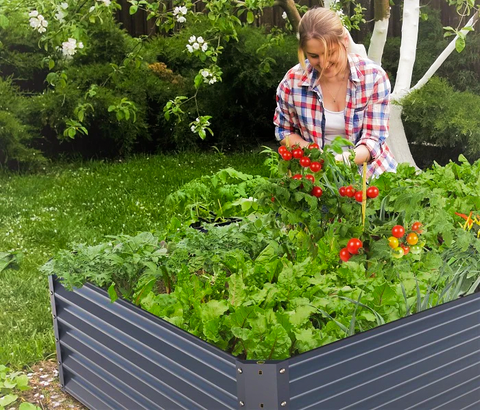Butterflies are enchanting creatures that bring life and color to any garden. Creating a butterfly garden not only adds beauty to your outdoor space but also supports the delicate ecosystem of these pollinators. If you're a gardening enthusiast looking to embark on a journey to attract these graceful insects, you're in the right place! In this comprehensive guide, we'll walk you through the steps of creating a stunning butterfly garden, complete with innovative designs, high-quality materials, and eco-friendly raised garden beds.The following content also has some reference value for raised garden beds.

Step 1: Choose the Right Location
Selecting the perfect spot for your butterfly garden is the first crucial step. Butterflies thrive in sunny areas protected from strong winds. Identify an area that receives at least 6 hours of sunlight daily. To maximize the visual appeal of your garden, consider placing it near a window or patio, allowing you to enjoy the fluttering beauties up close.
Step 2: Plan Your Garden Layout
Sketch a rough layout of your garden, keeping in mind the available space and your desired design. Consider incorporating winding pathways or curved edges, as butterflies are drawn to plants with interesting shapes. Incorporate innovative designs such as circular patterns, color gradients, or even a butterfly-shaped garden bed for a unique touch.
Step 3: Choose Butterfly-Friendly Plants
Selecting the right plants is crucial to attract and sustain butterflies throughout their lifecycle. Opt for native plants as they are adapted to the local climate and provide a familiar food source for local butterfly species. A mix of nectar-rich flowers and host plants for caterpillars will ensure a thriving ecosystem:
Nectar Plants:
- Coneflowers
- Black-eyed Susans
- Lantana
- Butterfly Bush
- Zinnias
- Marigolds
Host Plants:
- Milkweed (for Monarch butterflies)
- Dill (for Eastern Black Swallowtails)
- Fennel (for Eastern Black Swallowtails)
- Parsley (for Eastern Black Swallowtails)
- Passionflower (for Gulf Fritillaries)
Step 4: Consider Eco-Friendly Raised Garden Beds
For a truly innovative and sustainable butterfly garden, opt for eco-friendly raised garden beds. These beds provide better drainage, improved soil quality, and fewer issues with pests. They also make gardening more accessible, reducing the strain on your back and knees. Look for garden beds made from recycled materials or sustainably sourced wood, aligning with your commitment to an eco-conscious approach.
Step 5: Prepare the Soil
Prepare the soil in your raised garden beds by mixing compost, organic matter, and soil conditioner. Well-draining soil is essential for healthy plant growth and will attract a diverse range of butterflies. A healthy soil ecosystem will also encourage beneficial insects that prey on harmful pests, maintaining a balanced environment in your garden.
Step 6: Arrange Plants Creatively
When placing your chosen plants, keep in mind the heights, colors, and textures. Arrange taller plants at the back and shorter ones in the front to create depth and visual interest. To achieve an innovative and dynamic design, consider using a color gradient, with warm colors at one end and cooler colors at the other. This arrangement not only appeals to the human eye but also attracts butterflies seeking various nectar sources.
Step 7: Provide Water and Shelter
Butterflies need more than just flowers to thrive in your garden. They also require a water source for drinking and puddling. Place shallow dishes filled with water and a few rocks in your garden to create a butterfly-friendly watering station. Additionally, incorporate butterfly shelters like small shrubs or decorative rocks where these delicate creatures can rest during windy or rainy weather.
Step 8: Implement Sustainable Practices
Maintain your butterfly garden with eco-friendly practices to ensure its long-term success. Use organic fertilizers and pest control methods to avoid harming butterflies and their habitat. Avoid chemical pesticides, as they can disrupt the delicate balance of your garden ecosystem. Regularly weed and mulch your garden to keep it healthy and free from unwanted competition.

Step 9: Monitor and Enjoy
As your butterfly garden matures, take time to observe the incredible transformation and diversity it attracts. Keep a journal of the butterfly species you spot, noting their behaviors and interactions with your plants. Regularly inspect your plants for signs of pests or diseases, addressing any issues promptly to maintain the garden's health.
Step 10: Spread the Word
Share your journey of creating a butterfly garden on social media, in gardening forums, and with friends and family. Inspire others to follow suit and contribute to the conservation of these essential pollinators. Your innovative design choices, high-quality materials, and commitment to eco-friendly practices can set an example for sustainable gardening.
Conclusion
Creating a butterfly garden is a rewarding endeavor that combines innovation, beauty, and ecological awareness. By carefully selecting plants, incorporating eco-friendly raised garden beds, and implementing sustainable practices, you can create a haven for butterflies in your outdoor space. Your garden will not only be a visual delight but also contribute to the preservation of these enchanting creatures and the larger ecosystem they inhabit. So, roll up your sleeves, embrace your creativity, and embark on a journey to craft a vibrant butterfly garden that showcases nature's beauty at its finest.










